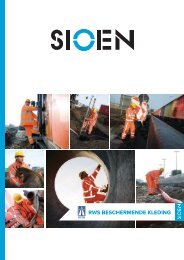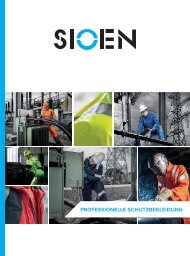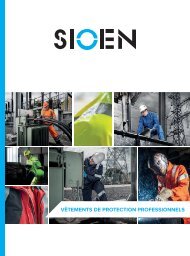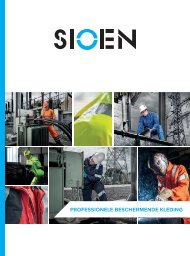Create successful ePaper yourself
Turn your PDF publications into a flip-book with our unique Google optimized e-Paper software.
Why wear flame retardant & anti-static clothing?<br />
European and national legislation stipulate measures<br />
to protect workers in areas with potentially explosive<br />
environments (ATEX).<br />
Two main European directives are of importance:<br />
1. ATEX Manufacturers Directive (94/9/EC or<br />
ATEX 95):<br />
Defines requirements concerning equipment and<br />
protective systems intended for use in potentially<br />
explosive atmospheres. The directive places<br />
responsibility on the manufacturer. Main responsibility<br />
is prevention of the formation and ignition of<br />
explosive atmospheres. This can be done by proving<br />
compliance against a set of health and safety<br />
requirements given in the directive. PPE which fall<br />
under the scope of directive 89/686/EC (such as EN<br />
1149-5 certified clothing) are explicitly excluded from<br />
this ATEX directive, meaning that clothing cannot be<br />
and should not be ATEX certified.<br />
2. ATEX Users Directive (99/92/EC or ATEX 137):<br />
Defines minimum requirements for improving safety<br />
and health conditions of workers potentially to be<br />
exposed to the risks from explosive atmospheres.<br />
The directive places responsibility on the employer.<br />
Typical responsibilities include:<br />
• Assessment of risks<br />
• Hazardous area classification<br />
• Removal of potential risks<br />
• Preparation of an Explosion protection Document<br />
• Put adequate warning safety signs in place<br />
• Prevention of and protection against explosions<br />
If the risk for an explosive atmosphere cannot be<br />
excluded the directive stipulates that:<br />
• The ignition of the explosive atmosphere must<br />
be avoided. Workers must be provided with the<br />
appropriate working garments which do not<br />
give rise to electrical discharges that can cause<br />
ignition of the explosive atmosphere.<br />
→ EN 1149 Anti-static protective clothing<br />
• The detrimental effects of an explosion should<br />
be reduced to ensure health and safety of the<br />
workers. This can be done by also providing<br />
workers with working garments offering heat and<br />
flame protection.<br />
→ EN ISO 11612 or EN ISO 14116 Flame retardant<br />
protective clothing.<br />
EN 1149-5<br />
EN 1149-5 <strong>Protective</strong> clothing. Electrostatic<br />
properties. Material performance and design<br />
requirements<br />
EN 1149-5 is part of a series of standards<br />
for test methods and requirements for<br />
electrostatic properties of protective clothing.<br />
EN 1149-5 specifies material and design<br />
requirements for electrostatic dissipative<br />
protective clothing. It covers clothing used<br />
as part of a total earthed system, to avoid<br />
incendiary discharges. The requirements<br />
may not be sufficient in oxygen enriched<br />
flammable atmospheres. This standard<br />
does not apply to protection against mains<br />
voltages.<br />
Some design / material requirements:<br />
• the outermost antistatic (AST) material shall<br />
permanently cover all non-complying layers (so<br />
the overlap of the antistatic outer shell must<br />
always be guaranteed when e.g. stretching,<br />
lifting arms, bending over, ...).<br />
• conductive trimmings are permitted (zips, buttons)<br />
but must be covered with AST outer fabric<br />
• non dissipative attachments (labels, retroreflective<br />
stripes, ...) are permitted when<br />
permanently attached<br />
• clothing must be donned and doffed outside the<br />
ATEX environment, worn fully closed and the<br />
wearer must be properly earthed<br />
• for materials containing conductive threads<br />
in a stripe or grid pattern, the spacing of the<br />
conductive threads in one direction shall not<br />
exceed 10mm in any part of the garment.<br />
Antistatic PPE are certified to EN1149-5 as this<br />
standard covers the performance requirements and<br />
refers to the choice of 2 different test methods:<br />
• EN1149-1: Measurement of surface resistivity<br />
• EN 1149-3: Measurement of charge decay<br />
NORMS<br />
MULTI-NORM NORMS & STANDARDS 379













